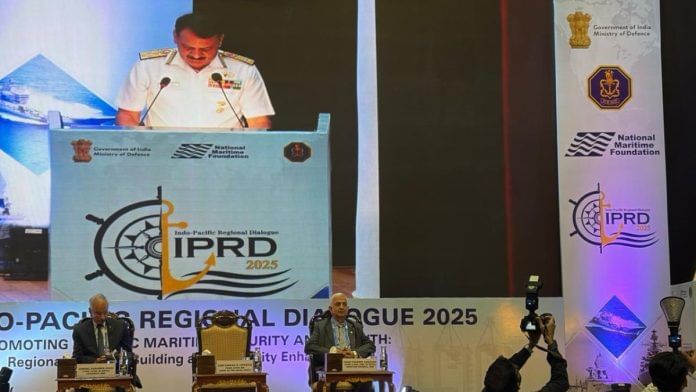New Delhi: The Indian Navy now faces pressures that are not isolated or episodic, but “complex, continuous and compounded”, Navy Chief Admiral Dinesh K. Tripathi said Monday while inaugurating the 11th edition of the Indo-Pacific Regional Dialogue (IPRD-2025) in New Delhi.
Declaring that the “seas are the truest measure of shared dignity”, Admiral Tripathi asserted that maritime security in the Indo-Pacific can no longer be viewed through the “narrow prism of strategic containment”.
Instead, he said, it must be seen as what Professor Rieckmann termed a “Dynaxic Challenge”—one that is both dynamic and complex.
The Navy Chief then went on to identify three major currents shaping this maritime “dynaxity”.
Trade and strategic frailty in maritime domain
According to the Navy Chief, the first concern is commercial disruption where global seaborne trade is under strain from “conflicts, coercion and catastrophe”. Citing data, he said global maritime trade growth is expected to stall at 0.5% in 2025, down from 2.2% last year, reflecting “not just slowed commerce, but strategic fragility”.
The ongoing Red Sea crisis, he added, demonstrated how disruption at a single chokepoint could ripple across global freight rates, insurance premiums, and food prices.
Second, the Navy Chief spoke about transnational turbulence. The seas, he said, are witnessing a surge in activities that blur “the lines between competition, crime and conflict”. Illegal, unreported and unregulated fishing, piracy, arms and narcotics trafficking, and human smuggling have emerged as major maritime stressors, he added.
“The maritime domain mirrors the wider disorder of our times,” Admiral Tripathi cautioned, adding that such challenges demand “collective solutions beyond jurisdiction or cartographic silos”.
Third, he went on to focus on technological acceleration as he spoke of how while disruptive technologies such as Artificial Intelligence, autonomous systems, and commercial satellites are reshaping maritime awareness and operations, these advances also bring vulnerabilities—from cyber intrusions to signal spoofing and persistent surveillance.
“In the Indian Ocean Region alone, there are near-daily episodes of GPS jamming,” he said.
According to him, therefore, “maritime security and maritime growth are not parallel tracks but twin propellers driving the collective voyage toward peace and prosperity”.
India’s MAHASAGAR initiative
Highlighting the Navy’s vision, he spoke on how India’s strategy had evolved from SAGAR (Security and Growth for All in the Region) to MAHASAGAR (Mutual and Holistic Advancement for Security and Growth Across Regions).
“Under MAHASAGAR, India’s defence-industrial transformation seeks to extend such cooperation beyond our shores, enabling friends and partners to strengthen their maritime presence with indigenous design, affordable technologies, and sustainable support systems. True capacity, after all, is not what a nation accumulates, but what a region aggregates,” he added.
Outlining the Navy’s approach, he called for “holistic maritime security” that integrates deterrence, law enforcement, environmental stewardship, and humanitarian response—but remains context-specific, not one-size-fits-all.
“Enhancing capability, therefore, demands a shift from platform-centric to purpose-centric thinking. It calls for doctrines that anticipate hybrid threats, training that fosters initiative and adaptability, and interoperability that allows navies to operate as one in moments that matter,” he concluded.
(Edited by Viny Mishra)
Also read: Navy gets first Tata-made Spanish 3D surveillance radar for its warships, 19 more to come






